
A | B | C | D | E | F | G | H | CH | I | J | K | L | M | N | O | P | Q | R | S | T | U | V | W | X | Y | Z | 0 | 1 | 2 | 3 | 4 | 5 | 6 | 7 | 8 | 9
Sub-Saharan Africa | |
|---|---|
 Geographical map of sub-Saharan Africa The Sahara The Sahel Sub-Saharan Africa
| |
| Major cities | Abidjan, Abuja, Accra, Addis Ababa, Cape Town, Dar es Salaam, Durban, Harare, Johannesburg, Juba, Kampala, Kinshasa, Lagos, Luanda, Lusaka, Mogadishu, Nairobi, Pretoria, Windhoek, Dodoma, Maputo, Jinja |
| Population (2021)[a] | 1,137,938,708 |
| Demonyms | African |
| Religions (2020) | |
| • Christianity | 62.0% |
| • Islam | 31.4% |
| • Traditional faiths | 3.2% |
| • No religion | 3.0% |
| • Other | 0.4% |
| Languages | Over 1,000 languages |
| Internet TLD | .africa |
| |
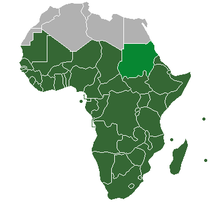
Lighter green: The Sudan, classified as a part of North Africa by the United Nations Statistics Division[2] instead of Eastern Africa, though the organization states that "the assignment of countries or areas to specific groupings is for statistical convenience and does not imply any assumption regarding political or other affiliation of countries or territories."
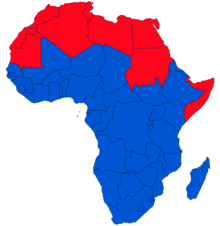

Sub-Saharan Africa, Subsahara, or Non-Mediterranean Africa[3] is the area and regions of the continent of Africa that lie south of the Sahara. These include Central Africa, East Africa, Southern Africa, and West Africa. Geopolitically, in addition to the African countries and territories that are situated fully in that specified region, the term may also include polities that only have part of their territory located in that region, per the definition of the United Nations (UN).[4] This is considered a non-standardized geographical region with the number of countries included varying from 46 to 48 depending on the organization describing the region (e.g. UN, WHO, World Bank, etc.). The African Union (AU) uses a different regional breakdown, recognizing all 55 member states on the continent—grouping them into five distinct and standard regions.
The term serves as a grouping counterpart to North Africa, which is instead grouped with the definition of MENA (i.e. Middle East and North Africa) as it is part of the Arab world, and most North African states are likewise members of the Arab League. However, while they are also member states of the Arab League, the Comoros, Djibouti, Mauritania, and Somalia (and sometimes Sudan) are all geographically considered to be part of sub-Saharan Africa.[5] Overall, the UN Development Programme applies the "sub-Saharan" classification to 46 of Africa's 55 countries, excluding Djibouti, SADR, Somalia, and Sudan.[6]
Since around 3900 BCE,[7][8] the Saharan and sub-Saharan regions of Africa have been separated by the extremely harsh climate of the sparsely populated Sahara, forming an effective barrier that is interrupted only by the Nile in Sudan, though navigation on the Nile was blocked by the Sudd and the river's cataracts. There is also an evident genetic divide between North Africa and sub-Saharan Africa that dates back to the Neolithic. The Sahara pump theory explains how flora and fauna (including Homo sapiens) left Africa to penetrate Eurasia and beyond. African pluvial periods are associated with a "Wet Sahara" phase, during which larger lakes and more rivers existed.[9]
Nomenclature

Geographers historically divided the region into several distinct ethnographic sections based on each area's respective inhabitants.[10]
Commentators in Arabic in the medieval period used the general term bilâd as-sûdân ("Land of the Blacks") for the vast Sudan region (an expression denoting Central and West Africa),[11] or sometimes extending from the coast of West Africa to Western Sudan.[12] Its equivalent in Southeast Africa was Zanj ("Country of the Blacks"), which was situated in the vicinity of the Great Lakes region.[10][12]
The geographers drew an explicit ethnographic distinction between the Sudan region and its analogue Zanj, from the area to their extreme east on the Red Sea coast in the Horn of Africa.[10] In modern-day Ethiopia and Eritrea was Al-Habash or Abyssinia,[13] which was inhabited by the Habash or Abyssinians, who were the forebears of the Habesha.[14] In northern Somalia was Barbara or the Bilad al-Barbar ("Land of the Berbers"), which was inhabited by the Eastern Baribah or Barbaroi, as the ancestors of the Somalis were referred to by medieval Arab and ancient Greek geographers, respectively.[10][15][16][17]
In the 19th and 20th centuries, the populations south of the Sahara were divided into three broad ancestral groups: Hamites and Semites in the Horn of Africa and Sahel related to those in North Africa, who spoke languages belonging to the Afroasiatic family; Negroes in most of the rest of the subcontinent (hence, the toponym Black Africa for Africa south of the Sahara[18]), who spoke languages belonging to the Niger-Congo and Nilo-Saharan families; and Khoisan in Southern Africa, who spoke languages belonging to the Khoisan family.
Climate zones and ecoregions
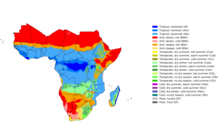
Sub-Saharan Africa has a wide variety of climate zones or biomes. South Africa and the Democratic Republic of the Congo in particular are considered megadiverse countries. It has a dry winter season and a wet summer season.
- The Sahel extends across all of Africa at a latitude of about 10° to 15° N. Countries that include parts of the Sahara Desert proper in their northern territories and parts of the Sahel in their southern region include Mauritania, Mali, Niger, Chad, and Sudan. The Sahel has a hot semi-arid climate.
- South of the Sahel, a belt of savanna (the West and East Sudanian savannas) stretch from the Atlantic Ocean to the Ethiopian Highlands. The more humid Guinean and Northern Congolian forest–savanna mosaic lie between the savannas and the equatorial forests.
- The Horn of Africa includes hot desert climate along the coast but a hot semi-arid climate can be found much more in the interior, contrasting with savanna and moist broadleaf forests in the Ethiopian Highlands.
- Tropical Africa encompasses tropical rainforest stretching along the southern coast of West Africa and across most of Central Africa (the Congo) west of the African Great Lakes.
- In East Africa, woodlands, savannas, and grasslands are found in the equatorial zone, including the Serengeti ecosystem in Tanzania and Kenya.
- Distinctive Afromontane forests, grasslands, and shrublands are found in the high mountains and mountain ranges of eastern Africa, from the Ethiopian Highlands to South Africa.
- South of the equatorial forests, the Western and Southern Congolian forest–savanna mosaic are transition zones between the tropical forests and the miombo woodland belt that spans the continent from Angola to Mozambique and Tanzania.
- The Namib and Kalahari Deserts lie in Southern Africa, and are surrounded by semi-deserts including the Karoo region of South Africa. The Bushveld grasslands lie to the east of the deserts.
- The Cape Floristic Region is at Africa's southern tip, and is home to diverse subtropical and temperate forests, woodlands, grasslands, and shrublands.
History
Prehistory

According to paleontology, early hominid skull anatomy was similar to that of their close cousins, the great African forest apes, gorilla and chimpanzee. However, they had adopted a bipedal locomotion and freed hands, giving them a crucial advantage enabling them to live in both forested areas and on the open savanna at a time when Africa was drying up, with savanna encroaching on forested areas. This occurred 10 million to 5 million years ago.[19]
By 3 million years ago several australopithecine hominid species had developed throughout Southern, East, and Central Africa. They were tool users rather than tool manufacturers. The next major evolutionary step occurred around 2.3 million BCE, when primitive stone tools were used to scavenge the carcasses of animals killed by other predators, both for their meat and their marrow. In hunting, H. habilis was most likely not capable of competing with large predators and was more prey than hunter, although H. habilis likely did steal eggs from nests and may have been able to catch small game and weakened larger prey such as cubs and older animals. The tools were classed as Oldowan.[20]
Roughly 1.8 million years ago, Homo ergaster first appeared in the fossil record in Africa. From Homo ergaster, Homo erectus (upright man) evolved 1.5 million years ago. Some of the earlier representatives of this species were small-brained and used primitive stone tools, much like H. habilis. The brain later grew in size, and H. erectus eventually developed a more complex stone tool technology called the Acheulean. Potentially the first hominid to engage in hunting, H. erectus mastered the art of making fire. They were the first hominids to leave Africa, going on to colonize the entire Old World, and perhaps later on giving rise to Homo floresiensis. Although some recent writers suggest that H. georgicus, a H. habilis descendant, was the first and most primitive hominid to ever live outside Africa, many scientists consider H. georgicus to be an early and primitive member of the H. erectus species.[21]
The fossil and genetic evidence shows Homo sapiens developed in Southern and East Africa by around 350,000 to 260,000 years ago[22][23][24] and gradually migrated across the continent in waves. Between 50,000 and 60,000 years ago, their expansion out of Africa launched the colonization of the planet by modern humans. By 10,000 BCE, Homo sapiens had spread to all corners of the world. This dispersal of the human species is suggested by linguistic, cultural and genetic evidence.[20][25]
During the 11th millennium BP, pottery was independently invented in West Africa, with the earliest pottery there dating to about 9,400 BC from central Mali.[26] It spread throughout the Sahel and southern Sahara.[27]
After the Sahara became a desert, it did not present a totally impenetrable barrier for travelers between north and south because of the application of animal husbandry towards carrying water, food, and supplies across the desert. Prior to the introduction of the camel,[28] the use of oxen, mule, and horses for desert crossing was common, and trade routes followed chains of oases that were strung across the desert. The trans-saharan trade was in full motion by 500 BCE with Carthage being a major economic force for its establishment.[29][30][31] It is thought that the camel was first brought to Egypt after the Persian Empire conquered Egypt in 525 BCE, although large herds did not become common enough in North Africa for camels to be the pack animal of choice for the trans-saharan trade.[32]
West Africa
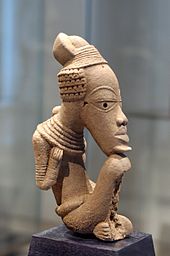
The Bantu expansion is a major migration movement that originated in West Central Africa (possibly around Cameroon) around 2500 BCE, reaching East and Central Africa by 1000 BCE and Southern Africa by the early centuries CE.
The Djenné-Djenno city-state flourished from 250 BCE to 900 CE and was influential to the development of the Ghana Empire. The Nok culture of Nigeria (lasting from 1,500 BCE to 200 CE) is known from a type of terracotta figure.[33] There were a number of medieval empires of the southern Sahara and the Sahel, based on trans-Saharan trade, including the Ghana Empire and the Mali Empire, Songhai Empire, the Kanem Empire and the subsequent Bornu Empire.[34] They built stone structures like in Tichit, but mainly constructed in adobe. The Great Mosque of Djenne is most reflective of Sahelian architecture and is the largest adobe building in the world.
In the forest zone, several states and empires such as Bono State, Akwamu and others emerged. The Ashanti Empire arose in the 18th century in modern-day Ghana.[35] The Kingdom of Nri, was established by the Igbo in the 11th century. Nri was famous for having a priest-king who wielded no military power. Nri was a rare African state which was a haven for freed slaves and outcasts who sought refuge in their territory. Other major states included the kingdoms of Ifẹ and Oyo in the western block of Nigeria which became prominent about 700–900 and 1400 respectively, and center of Yoruba culture. The Yoruba's built massive mud walls around their cities, the most famous being Sungbo's Eredo. Another prominent kingdom in southwestern Nigeria was the Kingdom of Benin 9th–11th century whose power lasted between the 15th and 19th century and was one of the greatest Empires of African history documented all over the world. Their dominance reached as far as the well-known city of Eko which was named Lagos by the Portuguese traders and other early European settlers. The Edo-speaking people of Benin are known for their famous bronze casting and rich coral, wealth, ancient science and technology and the Walls of Benin, which is the largest man-made structure in the world.
In the 18th century, the Oyo and the Aro confederacy were responsible for most of the slaves exported from modern-day Nigeria, selling them to European slave traders.[36] Following the Napoleonic Wars, the British expanded their influence into the Nigerian interior. In 1885, British claims to a West African sphere of influence received international recognition, and in the following year the Royal Niger Company was chartered under the leadership of Sir George Goldie. In 1900, the company's territory came under the control of the British government, which moved to consolidate its hold over the area of modern Nigeria. On 1 January 1901, Nigeria became a British protectorate as part of the British Empire, the foremost world power at the time. Nigeria was granted its independence in 1960 during the period of decolonization.
Central Africa
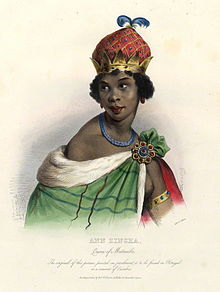
Archeological finds in Central Africa provide evidence of human settlement that may date back over 10,000 years.[37] According to Zangato and Holl, there is evidence of iron-smelting in the Central African Republic and Cameroon that may date back to 3,000 to 2,500 BCE.[38] Extensive walled sites and settlements have recently been found in Zilum, Chad. The area is located approximately 60 km (37 mi) southwest of Lake Chad, and has been radiocarbon dated to the first millennium BCE.[39][40]
Trade and improved agricultural techniques supported more sophisticated societies, leading to the early civilizations of Sao, Kanem, Bornu, Shilluk, Baguirmi, and Wadai.[41]
Following the Bantu Migration into Central Africa, during the 14th century, the Luba Kingdom in southeast Congo came about under a king whose political authority derived from religious, spiritual legitimacy. The kingdom controlled agriculture and regional trade of salt and iron from the north and copper from the Zambian/Congo copper belt.[42]
Rival kingship factions which split from the Luba Kingdom later moved among the Lunda people, marrying into its elite and laying the foundation of the Lunda Empire in the 16th century. The ruling dynasty centralised authority among the Lunda under the Mwata Yamyo or Mwaant Yaav. The Mwata Yamyo's legitimacy, like that of the Luba king, came from being viewed as a spiritual religious guardian. This imperial cult or system of divine kings was spread to most of central Africa by rivals in kingship migrating and forming new states. Many new states received legitimacy by claiming descent from the Lunda dynasties.[42]
The Kingdom of Kongo existed from the Atlantic west to the Kwango river to the east. During the 15th century, the Bakongo farming community was united with its capital at M'banza-Kongo, under the king title, Manikongo.[42] Other significant states and peoples included the Kuba Kingdom, producers of the famous raffia cloth, the Eastern Lunda, Bemba, Burundi, Rwanda, and the Kingdom of Ndongo.
East Africa
Sudan

Nubia, covered by present-day northern Sudan and southern Egypt, was referred to as "Aethiopia" ("land of the burnt face") by the Greeks.[43] Nubia in her greatest phase is considered sub-Saharan Africa's oldest urban civilisation. Nubia was a major source of gold for the ancient world. Nubians built famous structures and numerous pyramids. Sudan, the site of ancient Nubia, has more pyramids than anywhere else in the world.[44][better source needed]
Horn of Africa
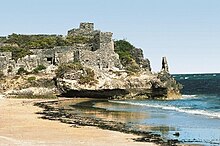
The Axumite Empire spanned the southern Sahara, south Arabia and the Sahel along the western shore of the Red Sea. Located in northern Ethiopia and Eritrea, Aksum was deeply involved in the trade network between India and the Mediterranean. Growing from the proto-Aksumite Iron Age period (c. 4th century BCE), it rose to prominence by the 1st century CE. The Aksumites constructed monolithic stelae to cover the graves of their kings, such as King Ezana's Stele. The later Zagwe dynasty, established in the 12th century, built churches out of solid rock. These rock-hewn structures include the Church of St. George at Lalibela.

In ancient Somalia, city-states flourished such as Opone, Mosyllon and Malao that competed with the Sabaeans, Parthians and Axumites for the wealthy Indo–Greco–Roman trade.[45]
In the Middle Ages several powerful Somali empires dominated the region's trade, including the Ajuran Sultanate, which excelled in hydraulic engineering and fortress building,[46] the Sultanate of Adal, whose General Ahmed Gurey was the first African commander in history to use cannon warfare on the continent during Adal's conquest of the Ethiopian Empire,[47] and the Geledi Sultanate, whose military dominance forced governors of the Omani empire north of the city of Lamu to pay tribute to the Somali Sultan Ahmed Yusuf.[48][49][50]
Southeast Africa
According to the theory of recent African origin of modern humans, the mainstream position held within the scientific community, all humans originate from either Southeast Africa or the Horn of Africa.[51] During the first millennium CE, Nilotic and Bantu-speaking peoples moved into the region, and the latter now account for three-quarters of Kenya's population.

On the coastal section of Southeast Africa, a mixed Bantu community developed through contact with Muslim Arab and Persian traders, leading to the development of the mixed Arab, Persian and African Swahili City States.[52] The Swahili culture that emerged from these exchanges evinces many Arab and Islamic influences not seen in traditional Bantu culture, as do the many Afro-Arab members of the Bantu Swahili people. With its original speech community centered on the coastal parts of Tanzania (particularly Zanzibar) and Kenya – a seaboard referred to as the Swahili Coast – the Bantu Swahili language contains many Arabic loan-words as a consequence of these interactions.[53]
The earliest Bantu inhabitants of the Southeast coast of Kenya and Tanzania encountered by these later Arab and Persian settlers have been variously identified with the trading settlements of Rhapta, Azania and Menouthias[54] referenced in early Greek and Chinese writings from 50 CE to 500 CE.[55][56][57][58][59][60][61][62] These early writings perhaps document the first wave of Bantu settlers to reach Southeast Africa during their migration.[63]
Between the 14th and 15th centuries, large medieval Southeast African kingdoms and states emerged, such as the Buganda,[64] Bunyoro and Karagwe[64] kingdoms of Uganda and Tanzania.
During the early 1960s, the Southeast African nations achieved independence from colonial rule.
Southern Africa
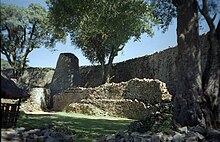
Settlements of Bantu-speaking peoples, who were iron-using agriculturists and herdsmen, were already present south of the Limpopo River by the 4th or 5th century displacing and absorbing the original Khoisan speakers. They slowly moved south, and the earliest ironworks in modern-day KwaZulu-Natal Province are believed to date from around 1050. The southernmost group was the Xhosa people, whose language incorporates certain linguistic traits from the earlier Khoisan inhabitants. They reached the Fish River in today's Eastern Cape Province. Monomotapa was a medieval kingdom (c. 1250–1629), which existed between the Zambezi and Limpopo rivers of Southern Africa in the territory of modern-day Zimbabwe and Mozambique. Its old capital was located at Great Zimbabwe.
In 1487, Bartolomeu Dias became the first European to reach the southernmost tip of Africa. In 1652, a victualling station was established at the Cape of Good Hope by Jan van Riebeeck on behalf of the Dutch East India Company. For most of the 17th and 18th centuries, the slowly expanding settlement was a Dutch possession. In 1795, the Dutch colony was captured by the British during the French Revolutionary Wars. The British intended to use Cape Town as a major port on the route to Australia and India. It was later returned to the Dutch in 1803, but soon afterward the Dutch East India Company declared bankruptcy, and the Dutch (now under French control) and the British found themselves at war again. The British captured the Dutch possession yet again at the Battle of Blaauwberg, commanded by Sir David Blair. The Zulu Kingdom was a Southern African tribal state in what is now KwaZulu-Natal in southeastern South Africa. The small kingdom gained world fame during and after their defeat in the Anglo-Zulu War. During the 1950s and early 1960s, most sub-Saharan African nations achieved independence from colonial rule.[65]
Demographics
Population


According to the 2022 revision of the World Population Prospects[66][67], the population of sub-Saharan Africa was 1.1 billion in 2019. The current growth rate is 2.3%. The UN predicts for the region a population between 2 and 2.5 billion by 2050[68] with a population density of 80 per km2 compared to 170 for Western Europe, 140 for Asia and 30 for the Americas.
Sub-Saharan African countries top the list of countries and territories by fertility rate with 40 of the highest 50, all with TFR greater than 4 in 2008. All are above the world average except South Africa and Seychelles.[69] More than 40% of the population in sub-Saharan countries is younger than 15 years old, as well as in Sudan, with the exception of South Africa.[70]
| Country | Population | Area (km2) | Literacy (M/F)[71] | GDP per Capita (PPP)[72] | Trans (Rank/Score)[73] | Life (Exp.)[71] | HDI | EODBR/SAB[74] | PFI (RANK/MARK) |
|---|---|---|---|---|---|---|---|---|---|
| 18,498,000 | 1,246,700 | 82.9%/54.2% | 6,800 | 168/2 | 42.4 | 0.486 | 172/171 | 132/58,43 | |
| 8,988,091 | 27,830 | 67.3%/52.2% | 700 | 168/1.8 | 49 | 0.316 | 176/130 | 103/29,00 | |
| 68,692,542 | 2,345,410 | 80.9%/54.1% | 800 | 162/11.9 | 46.1 | 0.286 | 182/152 | 146/53,50 | |
| 18,879,301 | 475,440 | 77%/59.8% | 3,700 | 146/2.2 | 50.3 | 0.482 | 171/174 | 109/30,50 | |
| 4,511,488 | 622,984 | 64.8%/33.5% | 700 | 158/2.8 | 44.4 | 0.343 | 183/159 | 80/17,75 | |
| 10,329,208 | 1,284,000 | 40.8%/12.8% | 2,300 | 175/1.6 | 50.6 | 0.328 | 178/182 | 132/44,50 | |
| 3,700,000 | 342,000 | 90.5%/79.0% | 800 | 162/1.9 | 54.8 | 0.533 | N/A | 116/34,25 | |
| 1,110,000 | 28,051 | 93.4%/80.3% | 37,400 | 168/1.8 | 51.1 | 0.537 | 170/178 | 158/65,50 | |
| 1,514,993 | 267,667 | 88.5%/79.7% | 18,100 | 106/2.9 | 56.7 | 0.674 | 158/152 | 129/43,50 | |
| 39,002,772 | 582,650 | 77.7%/70.2% | 3,500 | 146/2.2 | 57.8 | 0.519 | 95/124 | 96/25,00 | |
| 174,507,539 | 923,768 | 84.4%/72.7%[75] | 5,900 | 136/2.7 | 57 | 0.504 | 131/120 | 112/34,24 | |
| 10,473,282 | 26,338 | 71.4%/59.8% | 2,100 | 89/3.3 | 46.8 | 0.429 | 67/11 | 157/64,67 | |
| 212,679 | 1,001 | 92.2%/77.9% | 3,200 | 111/2.8 | 65.2 | 0.509 | 180/140 | NA |
